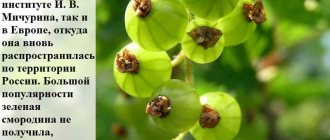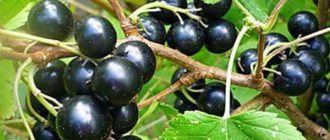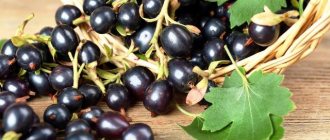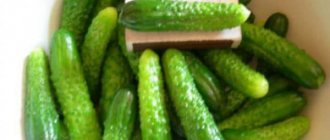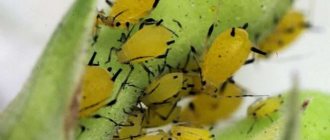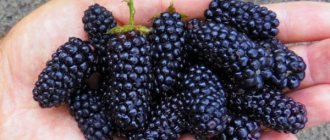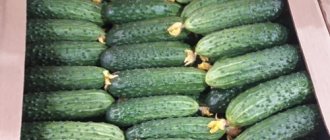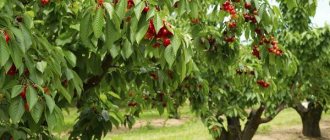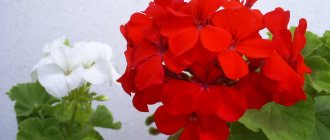Red currant Jonker Van Tets is a promising hybrid, selected in Holland in the first half of the twentieth century. The hybrid was obtained by crossing the varieties “Faya” and “London Market”.
It has been in the Russian State Register since 1992 and is recommended for breeding in the Volga, Central Black Earth and North-Western regions. The variety has become widespread throughout Russia.
The plant is strong, medium-ripening and high-yielding. The average height of the bush is 1.7 meters. The branches are thick, erect with dense foliage. The shoots are pubescent and colored beige.
Characteristics of Jonker Van Tets or Jonker
The plant is characterized by a strong above-ground part and a developed root system. The red currant variety "Jonker Van Tets" has some features characteristic of most hybrids.
Leaves
The leaves are larger than other varieties. They have a round shape and a dense structure. There are small protrusions on the central blade.
Each leaf has five well-developed triangular-shaped lobes. They are wide, equal in length and slightly pointed.
The leaf blade is slightly concave, with slight folding. The edge of the sheet is raised above the middle. Large teeth run along the perimeter of the leaf. The petiole is not too long, dense, with slight pubescence.
Tsvetkov
During the growing season, flowers appear from egg-shaped buds. They are saucer-shaped and large in size. The sepals are pale green with small lilac streaks. The petals have the shape of an inverse triangle. "Jonker Van Tets" forms fairly long tassels on which up to 10-12 berries are formed.
Fruits
This currant is distinguished by large bright red berries of a round or slightly elongated shape. They have a thick skin, and the juicy pulp contains 4-5 seeds. The weight of the fruit varies from 0.7 to 1.5 grams. The pulp is sweet and sour with a predominant sweet tint, so these berries are good for fresh consumption. Red currant berries are especially rich in potassium, magnesium, phosphorus and iron, which is useful for the normal functioning of the human body. They are also suitable for making jam, jam and jellies. The berries contain the following components:
- vitamins – A, B, C, E and PP;
- pectins;
- antioxidants;
- microelements.
Red currants are especially useful for children. It stimulates growth, normal skeletal development, activates brain function and strengthens memory.
Description and characteristics of the variety
The variety was obtained by crossing London Market and Faya Fertile currants. The plant is high-yielding (yield - 6.5 kg / bush), reaches an average height of 1.7 m. The bushes grow intensively, gradually becoming dense and erect. In the description of the red currant variety Jonker Van Tets, frost resistance is defined as high. The plant is rarely exposed to the negative effects of pests and the development of diseases.
The shoots are thick and flexible, so they do not break. The leaves are large, toothed, dark green in color. The buds are egg-shaped. The saucer-shaped flowers are as large as the currant leaves; the medium-sized flower cluster contains up to 10 berries.
Currant fruits are large, smooth, bright red, have a round shape and a dense top layer. The weight of the berries is 0.75-1.5 g. The pulp contains several large seeds. The taste is pleasant, sweet with sourness. The fruits are suitable for use in any form.
Advantages and disadvantages
This Dutch hybrid enjoys well-deserved popularity among domestic gardeners for its undoubted advantages:
- high self-pollination;
- good frost resistance;
- ease of care;
- transportability;
- resistance to most diseases.
The variety pollinates itself well, but if bushes of other varieties of red currant are planted nearby, the harvest will be noticeably larger. This is due to the positive effects of cross-pollination.
The plant tolerates frosty and long winters well and without consequences, however, the root system should be carefully covered with compost before the onset of cold weather. Caring for bushes is not difficult even for inexperienced gardeners. It is enough just to fulfill the most necessary requirements for caring for fruit crops. The harvested crop can be transported over long distances, since during harvesting the berries are easily torn off, do not flow or get wet.
"Jonker Van Tets" has high immunity and is resistant to anthracnose, powdery mildew and bud mites. These diseases and pests cause the greatest harm to red currant plantings. Among the disadvantages of the variety, experts note only low resistance to spring frosts. This is due to early flowering and if after the flowers open the temperature drops sharply, then the ovaries, as a rule, fall off and there will be no harvest
Landing Features
In most fruit and berry crops, the normal development of the plant and the subsequent receipt of a good harvest directly depends on the correct planting. This process consists of several stages:
- choice of location;
- compliance with planting deadlines;
- site preparation;
- selection of planting material;
- correct planting of seedlings.
Selecting a location
Red currant "Jonker Van Tets" prefers elevated and well-lit places. If there is insufficient lighting, the harvest will be plentiful, but the fruits will be too sour, since sunlight and heat stimulate the formation of sugars in the pulp of the berries. It is recommended to plant currant bushes along the fence or walls of houses, since this crop is very sensitive to northern winds. The groundwater level is very important for planting currants. The distance to them should not be less than two meters. If the groundwater is shallow and there are no elevated areas on the site, a drainage pad will have to be laid at the bottom of the planting hole.
Currants also do not like stagnant moisture, which you need to pay attention to when watering. When choosing a place to plant Jonker Van Tets, you should think about a favorable neighborhood. Red currants develop well and bear fruit next to gooseberries, but do not like the proximity to black currants and other berry bushes, especially those that produce root shoots. Vegetables, herbs and other crops with shallow roots can be planted nearby. Find out about the hybrid of currants and gooseberries in this material.
Planting onions or garlic next to red currants will protect the bush from many pests.
Landing dates
Spring is not a favorable time for planting. In spring, seedlings are purchased with blossoming leaves and a developed open root system. Such seedlings take root poorly, but if you follow some techniques, the result will be positive.
First of all, you need to remove the buds so that all the plant’s energy can be directed to rooting. Leaves, even withered ones, must be preserved, since next year’s buds are developing in their axils.
To stimulate the root system, before planting, the seedling is placed in water for 6-8 hours, adding one of the following drugs to it:
- Epin – 1 ml per 5 liters of water;
- zircon – 4 drops per 1 liter;
- Cornerost - 1 tablet per 2.5 liters.
The shoots should be shortened so that the aboveground part and the root system are the same size. After planting the seedling in the ground, it should be sprayed with Energen Extra. In the first days after planting, the young tree should be protected from direct sunlight and the soil should be kept constantly moist.
Summer planting of red currants is permissible if the seedling is purchased at the end of winter in a container with a closed root system and blossoming leaves. These are plants that were unsold in the fall and spent the winter in the refrigerator or basement. Such plants cannot be planted in the spring, as they can immediately die from unsettled temperatures and bright sun. During the spring they should be kept on a windowsill or in a greenhouse, and planted in open ground in the summer.
Autumn is the most favorable time for planting red currants. There is always time to prepare a site on the site. Fresh seedlings that have not been stored for a long time are usually available for sale.
Red currant seedlings need to be planted in early September, so that there is at least a month before the onset of cold weather, otherwise the plant will not have time to take root and will freeze.
Useful tips and tricks from experienced gardeners
Experienced gardeners who grow the Jonker variety know very well how to increase fruiting. It is not necessary to use chemical fertilizers - potato peelings can provide the necessary nutrients. It’s easy to use this kind of fertilizing - spread the soil around the bush in an even layer, cover it with a thick ball of soil (up to 5 cm), and water it generously. It is recommended to use potato peelings once a year - in early autumn.
Another trick is irrigation with boiling water, which allows you to destroy most of the pests lurking in the buds and soil in early spring. To do this, boil water, pour it into a watering can, wait a few minutes and generously irrigate the shoots of the plant. Don't worry about injuring the bush - it will handle a hot shower just fine. It is also recommended to shed the surface of the soil.
Jonker, according to gardeners, is a variety that has many advantages over other varieties. It is difficult to make mistakes in care even if you have no experience - the plant is undemanding. All that is needed is timely watering, loosening, application of nutrients, and removal of weeds.
Site preparation
It is best to plant currants on loamy or sandy loam soils with a pH value of 6 to 6.5. If the earth gives a more acidic reaction, it must be neutralized. To do this, you need to add 300-400 grams of powdered limestone or 200-300 grams of slaked lime per square meter of area to the soil. This article will tell you about the soil for currants.
For autumn planting, agrotechnical work should be carried out two months before the planting date, and in the spring the soil should be prepared at least two weeks before the start of work.
In red currants, the main part of the roots is located at a depth of 40 cm, so the soil should be loosened and dug to a depth of no more than 50 cm. The lower clay layer can simply be dug with a pitchfork. Fertilizers should be added to the top fertile layer. For each square meter of planting you need to add the following components:
- compost or rotted manure – 8 kg;
- superphosphate – 100 grams;
- potassium sulfate – 80 grams.
During the time before planting the seedlings, the soil will become compacted and fertilizers will penetrate the soil to the required depth.
Selection of seedlings
The correct growth and development of plants, and obtaining a good harvest, depend on the correct choice of seedlings. It is imperative to pay attention to the root system. Seedlings with developed and not dry roots are preferable. A slight peeling of the bark on the branches is allowed, the main thing is that they are not dry. You should not purchase seedlings with mechanical damage, spots of rot or mold. The height of the seedling starts from 40 cm.
Landing instructions
Planting one bush of Jonker Van Tets red currant is considered unprofitable, and gardeners usually plant 3-4 bushes of this variety and, to increase productivity, a couple of bushes of another variety. The distance between plantings is 1.5 meters. The planting holes have dimensions of 60 X 60 cm and a depth of 50 cm. Since mineral fertilizers were applied when preparing the site, it will be enough to add a little humus and wood ash to the fertile layer and mix everything. At the bottom of the planting hole you need to make a hole slightly larger than the root system. Place the seedling there at an angle of approximately 450 with its upper part facing north. The seedling must be buried in the hole so that its root collar is 5-8 cm underground. Then the hole must be filled in and the soil must be lightly compacted. An earthen roller should be formed around the bush, the plant should be watered and mulched with compost, peat or humus.
Seedling care
Caring for Jonker Van Tets red currant seedlings includes standard agrotechnical procedures such as watering, fertilizing, pruning, disease prevention and pest control.
Trimming
All shoots of one-year-old seedlings are cut in half, and a compact round bush is formed. Straight growing shoots are left from the shoots and growth lying on the ground or intertwined with other branches is removed. Sanitary pruning is carried out regularly during the autumn dormant period. Sick, dry, broken branches and branches growing in the wrong direction are pruned.
Watering
A strong root system allows red currants to survive without water for a long time, but the lack of moisture negatively affects the growth of the plant and the quality of the crop. Currants are actively watered in early June and early August. Water should not be poured at the root, but into a specially dug ditch at a distance of 30-40 cm from the bush. The soil should be saturated with moisture to a depth of 40 cm. Read how to feed red currants here.
Fertilizers for the variety
It is recommended to feed red currants three times during the season. At the end of April, 15-20 grams of granulated urea should be added to the soil under the currant bush. In mid-June, the bushes can be watered with a solution of manure at a rate of 1:10 or with the following mineral fertilizers:
- superphosphate – 20 grams;
- potassium sulfate – 15 grams;
- urea – 15 grams;
- water – 10 liters.
In the first week of October, along with digging up the tree trunk circle, up to 10 kg of rotted manure or compost with the addition of 100 grams of superphosphate and 50 grams of potassium chloride are added to it.
Shelter for the winter
It is very important to cover the Jonker Van Tets currant bushes in a timely manner for the winter. Here it is important not to cover the bushes too early, but you shouldn’t delay it either. The decrease in temperature must be permanent without returning to an increase. You can use it for shelter, but most gardeners prefer to use the cheaper but more reliable option made of burlap. First, the currant bush is tied with soft braid, starting from the bottom and bringing the branches together like a tulip. Then a regular bag is put on the tied bush. To prevent the bag from being blown away by the wind, you can tie it to pegs dug nearby.
Plant care
Water the plant in the early stages of growth in the morning and evening. 1 currant bush requires 10 liters of water. In the spring, you can slow down the pace, and after the ovaries appear, start abundant watering again.
They begin to fertilize the soil after the shoots begin to grow, with the end of winter. Composition of the standard mixture:
- organic fertilizer and 15 g of urea;
- after 2 weeks, add 40 g of superphosphate to the mixture;
- after another week, 20 g of superphosphate, 20 g of ammonium nitrate and 15 g of potassium sulfate are combined and transferred to a bucket of water.
The bucket is enough for 2 bushes. When the soil is depleted, special fertilizers rich in microelements are used. If nothing helps and the currant bush does not take root, then it is necessary to transplant it to another area.
Transplant methods
| Method 1 | Beginning August - Mid. August, plant the cuttings in a free place, care for them until spring, observing the appearance of roots. |
| Method 2 | Beginning summer, take cuttings, cut off the bark at the base, cut twice in the internodes, put in a jar of water, plant in the ground, cover with film (sometimes remove for ventilation), after the leaves appear, remove from the jar and film. |
| Method 3 | con. May - beginning In June, seedlings are prepared, planted and waited; after planting, it is necessary to cut off half of the shoots, and in the spring, remove the old shoots again. |
To keep Jonker van Tets intact until next year, you need to mulch the soil before the onset of frost. Horse humus is used for this. For the winter, the plant is covered with burlap and/or spruce branches, protecting them from the cold. As an option, you can use Spunbond material for cover in this way:
- tie the bush with a rope so that the branches do not fall apart;
- put a bag on top;
- secure it with pegs so that it does not fly away from strong winds.
It is recommended to pre-treat the plant against parasites and infections.
Diseases and pests
"Jonker Van Tets" is a variety with high immunity to a number of diseases, but preventive measures are still necessary. Red currants can be affected by the following diseases:
- anthracnose;
- septoria;
- glass rust;
- white coating (powdery mildew).
“Prognoz”, “Skor”, “Fitosporin-M” and “Chistoflor” can be used as therapeutic agents. To destroy pests, insecticides such as “Nitrophen”, “Karbofos”, “Inta-Vir” should be used.
Preparations containing copper help well against all types of fungal diseases. To do this, you can spray the plant with copper sulfate and treat it with Bordeaux mixture in the spring.
Agricultural technology
Red currant Jonker van Tets has good fruiting
Holes for planting are dug so that there is from 5 to 10 cm from the soil to the root system. It has been noticed that if different types of red currants are planted side by side, then this variety produces larger berries. There should be a distance of at least a meter between the bushes, and preferably one and a half. For a bush to be thick and spreading, it needs some free space. The plant does not need to be pollinated.
The main characteristic is that the plant is unpretentious in care, but there should be no shading when choosing a planting site. It needs to be well lit by the sun. Lack of sunlight will affect the taste and richness of the berries.
Regarding the soil: sandy loam or loamy soil is suitable. The soil must be loosened. They do this in the spring and again when the berry season ends.
In this case, the presence of groundwater should be taken into account. It is better that the root system does not touch them. Farmers note that currants should be planted near a fence or hedge to protect the plant from strong winds.
On a note. Since the variety blooms early, and frosts are possible in the spring, after that the ovaries may fall off.
Treatment
Although Jonker Van Tets red currant is disease resistant, in the spring it is necessary to carry out preventive measures against mites and anthracnose. For this purpose, antifungal drugs and fungicides are purchased. According to numerous reviews from farmers, copper sulfate works best against the second disease. Bordeaux mixture is also good. From the first, boiling water, which needs to be used to scald the branches, saves you. Before the branches begin to bloom, it is necessary to apply Fufanon. Colloidal sulfur is often used, and 150 grams should be dissolved in 10 liters of water.
With anthracnose, burn marks are visible on the leaves and shoots. If the currant has been attacked by a mite, the buds will be very large, as if swollen. Then the leaves at the top become lighter and begin to deform.
An infusion is made from onion peels and the plant is sprayed from time to time to prevent caterpillars, powdery mildew or aphids from infesting.
Fertilizers
Fertilize the plants according to the scheme, and it is strongly recommended to water them abundantly.
Even at the planting stage, Jonker is fertilized with organic fertilizers, watered at least 2 times a day: in the daytime, then in the evening. The norm is 1 bucket of water for 1 bush. In the spring, they water less often and in a smaller volume, however, when the fruits begin to ripen, regular watering will be required.
The first application of fertilizers is carried out in early spring when shoots are growing. Take 10-15 grams. urea and added to organic matter. In this case, 10 liters of fertilizer should be applied to 1 adult bush.
Then they wait 2 weeks and apply fertilizer again. The amount of fertilizer is the same, only superphosphate is added to the organic matter in an amount of 40 grams.
Red currant Jonker van Tets large harvest
They count down the week and fertilize for the third time. They take superphosphate, you need 20 grams, the same amount of ammonium nitrate and 5 grams. less potassium sulfate, mixed with 10 liters of water. For 1 bush = 5 liters of fertilizer.
When it’s time to water the plants in the fall (or water-recharging irrigation), phosphorus and potassium fertilizers are used, and a solution is made from them.
If the soil is depleted, it is necessary to use fertilizers with a higher effect. It is best to do foliar feeding in spring using microelements.
Replanting and pruning
There are 3 ways to transplant currants: green cuttings, woody ones and combined ones.
Method No. 1 is carried out in early summer. In the morning you need to cut the cuttings, then make cuts on them (the bark is cut twice at the internodes), then put them in previously prepared water. They are buried in the ground and covered with film. You can use a jar. It is necessary to water regularly, sometimes remove the jar (film) so that the cuttings are ventilated. If leaves are visible, remove the film. If it is clear that it can be planted, do it in the fall. If not, leave it until spring.
Pruning currants in spring
Method number 2 - at the beginning of August or in the middle. At the same time, they decide on a location and plant the cuttings there. Hill up and water until spring. The cuttings must develop roots so that they can survive the cold.
Harvesting and storing red currants
Red currants do not ripen at the same time, so their harvest can last up to 20 days. Dry berries are stored better than wet ones, so harvesting is not recommended early in the morning, during dew, or after rain. Red currant is a delicate berry and should be collected in whole bunches, without picking individual berries. The container capacity should not be more than 2-2.5 kg, so that the top layer of berries does not crush the lower ones. The berries are not intended for long-term storage, but they can be stored in the freezer of the refrigerator for 2-3 months. First, the berries are poured onto a baking sheet or plate and frozen. After this, the hard berries can be poured into any container and stored at a temperature of + 20C. Find out when red currants ripen here.
Growing and care
When the Jonker red currant variety began to be grown in Russia, suitable regions were selected: Northwestern, Volga-Vyatka, Central Black Earth. According to the description, the plant feels good in a temperate climate zone. Currants can withstand frost in winter or drought in summer. In the spring, when the air temperature fluctuates from minus to plus parameters, the surface around the bushes is mulched.
Selecting a location
For red currants of the Jonker Van Tets variety, choose a sunny place on the site. When planted in the shade, the berries do not have time to gain sugar and will turn out very sour. The harvest is also declining. A good location would be along fences or next to buildings. Plants cannot easily withstand northern winds.
When planting, take into account the height of groundwater. Red currants also do not like it when the water stagnates. If the site is located in a lowland, the planting places are made on a hill, and a thick drainage cushion is laid at the bottom of the hole. Then soil is poured into which humus or compost and wood ash are added.
The soil for Jonker Van Tets currants should be slightly acidic. The best option is loam and sandy loam soils.
Planting seedlings
Before starting work, seedlings are inspected for damage and disease. If there are signs of disease, it is better to refuse planting material. The seedlings are placed in water so that the root system is saturated with water.
In order for the plant to adapt faster after planting, the shoot is cut off by 2/3, and the leaves are also shortened. The seedling is placed in the hole at an angle of 45 degrees and watered abundantly. Then they cover it with earth. The soil is trampled down
Important! Jonker currant bushes are planted at a distance of 1-1.5 meters. How to plant red currants correctly:
How to plant red currants correctly:
Watering
Red currant variety Jonker Van Tets is described as a drought-resistant plant. Water it in the absence of rain 2-3 times a week. A bucket of water is poured under one bush.
Advice! You can water currants in the morning or evening.
In July and August the amount of water is increased. During this period, the fruits ripen on the bushes and flower buds are laid for fruiting in the next season. If there is not enough moisture, then not only the current, but also the future harvest may not be harvested.
Top dressing
For successful fruiting and a bountiful harvest, Jonker red currants are fed in the spring. At this time, the plants are fed with organic matter. Plants respond well to horse humus or humus. Be sure to add wood ash (100 grams per bush), which is then embedded in the soil when loosened.
Today, many gardeners refuse mineral fertilizers. But if they are used, then add the following nutrient mixture to each currant bush:
- double superphosphate – 70-80 grams;
- potassium sulfate – 30-40 grams.
Important! Any fertilizing is carried out on well-moistened soil.
Trimming
To obtain a stable harvest, red currant bushes of the Jonker Van Tets variety must be shaped. If pruning is done correctly, it will not only increase the yield, but also help the plant cope with diseases and pests.
Trimming Features:
- The bushes are pruned for the first time at the time of planting. The branches are cut by 2/3. Thanks to this procedure, the plant begins to bush and expels side shoots.
- In spring, pruning is carried out early, before the buds begin to swell. Remove frost-damaged or broken branches, and also trim the tops of the shoots by 5-6 centimeters.
- In the fall, after harvesting, old branches that have been bearing fruit for more than 4-5 years are cut out. Shoots with damage and disease must be removed. You need to cut the branches close to the ground so that there are no stumps left, as in the photo below.
- Red currant Jonker, according to the description and reviews of gardeners, grows greatly over the summer. That is why it is necessary to cut out excess growth so as not to weaken the bush.
If an adult bush is formed correctly, it should have about 15-20 shoots of different ages. Only healthy and strong branches are left for replacement. Experienced gardeners recommend rejuvenating the Jonker variety every year, removing the oldest shoots.
Cut shoots that are not damaged by diseases and pests can be used to propagate currants.
Transfer time
In order to propagate and plant red currant bushes correctly, you should first decide on the most suitable method for you:
- green cuttings. Carried out mainly in early summer. The cuttings are cut in the morning and placed in water, having first made cuts in the bark in two internodes. The next stage is burying the cuttings in the ground. It is recommended to cover them on top with a jar or film. The main thing is to provide complete care for the shoots. They need to be watered regularly, and also remove the jar from time to time to ventilate the cuttings. When the first leaves appear on them, the cover can be removed. If at the end of summer you can safely say that the cuttings are strong and ready for planting in the ground, this can be done this fall. Otherwise, leave the cuttings in the soil until spring;
- lignified cuttings. This procedure is carried out in early to mid-August. The shoots must be immediately planted in a permanent place. Until next spring, it is recommended to regularly water and hill up the seedlings. If you do everything correctly and the cuttings have time to take root, they will be able to wait out the winter cold without any problems;
- combined cuttings. At the end of May and beginning of June, seedlings are harvested. Once you bury them in the ground, they can take root within two weeks. Before this, you prepare them directly on the bush.
Which method and period of plant transplantation will be most optimal for you depends on how well you understand this or that method.
